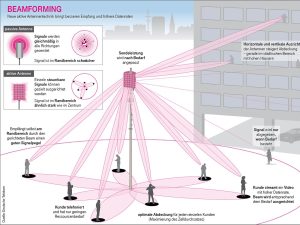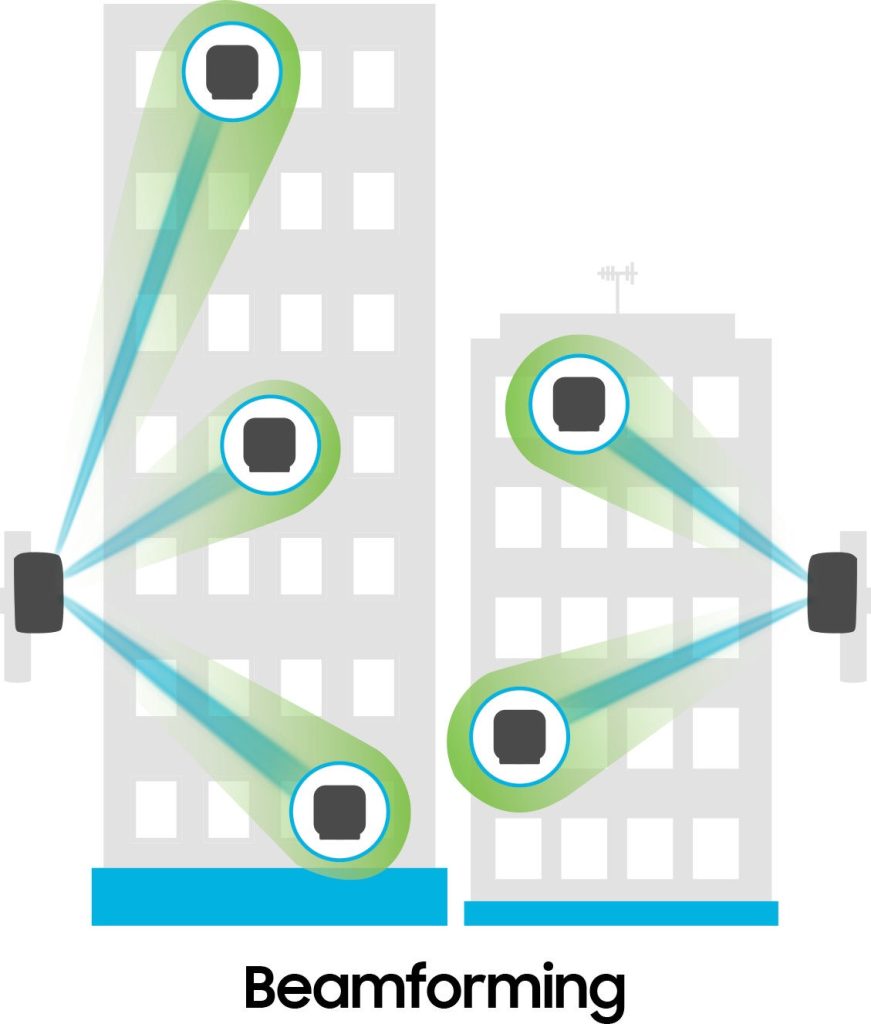The role of beamforming techniques in next-generation wireless communication systems cannot be overstated. As the demand for high-speed data transmission increases, advanced architecture and cutting-edge beamforming algorithms are required to achieve optimal performance in 5G networks. The sheer complexity of the task at hand requires a level of sophistication that is beyond comprehension.

MIMO systems, with their multiple antennas at both ends of the transmitter and receiver, have become an integral part of modern wireless communication networks. These systems can transmit multiple data streams simultaneously, thereby improving overall system performance and increasing network capacity. However, when combined with beamforming techniques, MIMO technology takes on a whole new dimension by enhancing signal quality and coverage.
Enter massive MIMO – an advancement in traditional MIMO technology that utilizes hundreds or thousands of antennas at the base station to serve multiple users simultaneously. The potential for even higher capacities than traditional MIMO while reducing power consumption per user has created a buzz within the industry. But achieving this level of performance is no easy feat; sophisticated beamforming techniques for antenna arrays must be employed to optimize signal quality while minimizing interference between users – it’s enough to make one’s head spin!
Understanding MIMO Systems and Their Importance in Architecture
Contents
- 1 Understanding MIMO Systems and Their Importance in Architecture
- 2 The Advancements of Massive MIMO in Transmitting Multiple Data Streams
- 3 The Use of Antenna Arrays in Achieving Digital Beamforming for Wireless Communication
- 4 The Importance of Hybrid Beamforming Algorithms in MIMO Systems
- 5 The Benefits of Adaptive RF Chain for Beamforming Antenna Arrays
- 6 Overcoming Limitations in Beamforming Techniques for Massive MIMO Systems
- 7 Achieving the Highest System Performance with Precoding Techniques in Beamforming Antenna Arrays.
The perplexing and bursty nature of MIMO systems has become a fundamental element in wireless communication architecture. With their capability to transmit multiple data streams concurrently, the evolution of MIMO technology has led to the development of massive MIMO – an array system that utilizes a vast number of antennas. This innovation is expected to play an instrumental role in 5G networks by enhancing network capacity and coverage.

One key technique used in MIMO systems for wireless communication is digital beamforming, which involves adjusting signals’ phase and amplitude transmitted by each antenna element within the array system. Digital beamforming ensures efficient signal transmission while minimizing interference from other signals.
Another crucial component that helps optimize MIMO system performance are beamforming antennas. By leveraging both analog and digital processing techniques, these antennas adjust signal directionality towards target receivers while reducing interference from other sources. Additionally, smart antenna arrays employ adaptive RF chains that enable optimal beamforming performance even under challenging conditions such as fading or multipath propagation.
In conclusion, grasping the importance of MIMO systems within architecture is critical for achieving high-performance wireless communications networks. With cutting-edge advancements like massive MIMO, digital beamforming, and smart antenna arrays- significant improvements in network capacity and coverage can be expected – especially with the upcoming deployment of 5G networks worldwide!
The Advancements of Massive MIMO in Transmitting Multiple Data Streams
The technology known as Massive MIMO (Multiple-Input Multiple-Output) has been gaining popularity in wireless communication systems due to its ability to transmit multiple data streams simultaneously, but how exactly does it work? The answer lies in the clever use of a large number of antennas in the array which allows for spatial multiplexing. From tens to hundreds or even thousands of antennas can be used in such a system.
However, simply having numerous antennas is not enough to achieve high performance with massive MIMO; beamforming techniques are essential. Beamforming involves directing the transmitted signal towards the intended receiver and minimizing interference from other directions – but there are two types: analog beamforming and digital beamforming. Analog beamforming may be simpler than digital, but it’s also less flexible, requiring more complex algorithms.
Enter hybrid beamforming – an approach that combines both analog and digital processes for better performance while reducing cost and complexity. With this technique, some antennas use analog processing while others use digital processing based on an algorithm that optimizes the overall system performance. Adaptive RF chains enable hybrid beamforming by dynamically adjusting phase shifters used in antenna arrays based on changing channel conditions.
In summary, through utilizing massive MIMO technology along with adaptive RF chains and hybrid beamforming approaches it’s possible to achieve higher spectral efficiency and lower energy consumption compared to traditional methods of transmitting signals over wireless communication systems without compromising quality or reliability – quite impressive indeed!
The Use of Antenna Arrays in Achieving Digital Beamforming for Wireless Communication
The technique of digital beamforming, oh how perplexing it can be! Its implementation in wireless communication systems is known to enhance system performance. Through the use of an array of antenna elements, this technique steers radio frequency energy towards a specific direction, reducing interference and amplifying signal strength at the receiver. Digital beamforming algorithms are typically implemented on digital signal processors (DSPs) within base stations or in baseband.
However, one must not underestimate the burstiness of its architecture as it varies depending on deployment scenarios. Smart antennas with adaptive beamforming capabilities may be deployed in mobile environments where user location and movement patterns tend to fluctuate greatly. Whereas for point-to-point communication links or small cell deployments, stationary antenna arrays with static beamforming may prove more appropriate.
Researchers and standardization bodies such as IEEE have been paying close attention to techniques for massive MIMO systems due to their potentiality for enhancing spectral efficiency and capacity. In fact, hybrid beamforming algorithms that combine analog and digital processing have been proposed as a way around certain limitations associated with purely digital approaches – high power consumption and hardware complexity being two significant factors here. It’s safe to say that innovations like digital beamforming continue pushing advances in antenna technology and signal processing which ultimately drive improvements in wireless communication system performance overall!
The Importance of Hybrid Beamforming Algorithms in MIMO Systems
The realm of MIMO systems and beamforming antenna array technologies is evolving at a rapid pace. As the 5G revolution gains momentum, the need for increased throughput and bandwidth has become paramount. In response to this demand, advanced techniques such as hybrid beamforming algorithms have emerged as crucial components in next-generation wireless communication systems.
Among these techniques, digital and hybrid beamforming have garnered significant attention due to their ability to enhance system performance. Digital beamforming involves processing baseband signals in the digital domain before transmitting them through RF chains, while hybrid beamforming combines analog and digital processing for optimized signal transmission paths without sacrificing hardware complexity.
Wireless communication necessitates large numbers of RF chains for high-resolution beams from beamforming antenna arrays which poses challenges related to cost and power consumption. However, hybrid beamforming addresses these obstacles by using fewer RF chains than traditional approaches but still achieving highly precise beams via precoding techniques that maximize signal efficiency.
Antenna array technologies are expected to play an increasingly vital role in future wireless communication systems – especially massive MIMO systems combined with advanced beamforming techniques that use adaptive RF chain technology capable of reducing energy usage during operation without compromising performance levels. Ultimately, Hybrid Beamforming Algorithms offer promising solutions for tackling modern challenges associated with efficient deployment of Beam Forming Antenna Array Technologies within Wireless Communication Systems.
The Benefits of Adaptive RF Chain for Beamforming Antenna Arrays
The Adaptive RF Chain technology has proven to be an indispensable tool in the realm of beamforming antenna arrays. Its role is particularly significant in wireless communication systems that utilize the massive multiple input multiple output (MIMO) architecture. For years, beamforming techniques have been implemented to enhance wireless communication performance. However, adaptive RF chains take it a step further and enable even more impressive results.
In conventional beamforming approaches, array systems are constructed with phase shifters and amplifiers that remain static and cannot be altered during operation. With adaptive RF chain technology though, these components can be reconfigured dynamically based on system demands at any given time. This allows for more optimal use of resources and greater overall performance improvements.
One major benefit of using adaptive RF chains for antenna beamforming is the enhanced control over the antenna pattern they provide. As such, beams can now be targeted towards specific users or locations while interference from other sources is minimized. In addition to this advantage, fewer RF chains are needed for effective beamforming which means smaller antennas can suffice leading to cost savings as well as easier installation procedures.
Overall, Adaptive RF Chain plays a critical role in achieving high-performance beamforming especially within 5G networks where reliable wireless communications are essential for businesses and individuals alike. Given its significance in enhancing signal strength while minimizing interference between different devices on a network we expect it will continue being pivotal in future advancements within this field as we progress into increasingly interconnected societies.\n
Overcoming Limitations in Beamforming Techniques for Massive MIMO Systems
The perplexing demands of next-generation wireless communication systems are igniting a fierce need for enhanced performance in Massive MIMO systems. Beamforming techniques, while crucial to reaching optimal system performance, face their own set of constraints that must be tackled with urgency.
One such limitation is the fact that conventional beamformers used in MIMO systems were designed exclusively for narrowband usage and struggle to deliver top-notch results in wideband scenarios. A possible solution to this quandary lies in digital antenna arrays which when coupled with baseband and RF technologies can regulate the direction of radio communication signals, surpassing traditional beamforming methods by providing higher levels of functionality.
Another hindrance arises from LTE-based MIMO systems which require complex algorithms for deriving optimal beamforming outcomes; hybrid beamforming algorithms have been developed as an answer to improve overall system performance by combining analog and digital processing techniques.
To achieve peak proficiency within Massive MIMO systems, adaptive RF chains can also be employed alongside beamformer technology. This allows for real-time adjustments based on fluctuating signal conditions ensuring unparalleled signal quality at all times.
In conclusion, these sophisticated technologies will undoubtedly play an invaluable role in overcoming limitations and boosting the overall efficacy of Massive MIMO systems catering to next-gen wireless communication requirements. With advanced digital antenna arrays, hybrid beamforming algorithms, and adaptive RF chains at our disposal it is feasible to attain unmatched levels of system efficiency whilst maintaining compatibility with existing LTE-based MIMO standards.
Achieving the Highest System Performance with Precoding Techniques in Beamforming Antenna Arrays.
The ins and outs of precoding techniques are vital for achieving top-notch system performance with beamforming antenna arrays. These techniques are a must-have in meeting the requirements of next-gen wireless communication systems, which demand high data rates and low latency. Whether uplink or downlink transmissions, precoding can enhance channel capacity while reducing interference.
For optimal effectiveness, multiple antennas are necessary to make precoding work its magic. These antennas can be categorized into two groups: transmit antennas and receive antennas. By harnessing several antennas, an orthogonal beam can be created that zeros in on the desired user while dampening interference from other users or noise sources. Additionally, tweaking each antenna element’s phase and amplitude helps steer the beam towards a specific angle of arrival.
One standout perk is how precoding surpasses limitations tied to analog beamforming methods like phase shifting networks (PSNs). Unlike PSNs, precoding enables digital processing at baseband frequencies for more precise signal transmission control. Adaptive algorithms also come into play to optimize performance under varying conditions such as changes in network congestion or user location. All things considered, it’s clear that precoding is a mighty tool that maximizes available resources while delivering peak system performance for tomorrow’s wireless communication systems.


